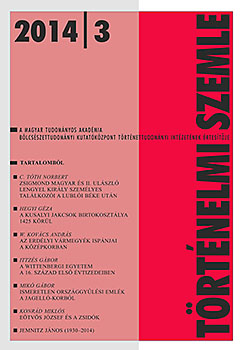Zsigmond magyar és II. Ulászló lengyel király személyes találkozói a lublói béke után (1412–1424)
The Personal Meetings between Kings Sigismund of Hungary and Wladislaw II of Poland after the Peace of Lublin (1412–1424)
Author(s): Norbert C. TóthSubject(s): Diplomatic history, Political history, 15th Century
Published by: Magyar Tudományos Akadémia Bölcsészettudományi Kutatóközpont Történettudományi Intézet
Keywords: Sigismund of Hungary; Wladislaw II of Poland; king; personal meeting; after the Peace of Lublin; 1412–1424;
Summary/Abstract: The relationship between Sigismund of Luxemburg, king of Hungary (1387–1437), of the Romans (1410–1433) and of Bohemia (1420–1437), and Wladislaw II Jagiello, king of Poland (1386–1434), was at the time of their accession to the throne influenced by the problems caused by the disputed status of Galicia and Lodomeria and by the equally disputed over lordship over the princes of Moldavia and Wallachia. These problems were settled on 14 July 1397 at Igló (Spišská Nová Ves, Slovakia), where during a meeting of the two rulers and their chief men a peace was ordered for sixteen years on the basis of the status quo. Thereafter, in the early 15th century, the relationship between the two kings was already shaped by their respective attitudes towards the Teutonic Order. The consequent tension increased until an armed conflict broke out (1410–1411). After the united forces of Poland and Lithuania had defeated the Order at Tannenberg and made peace at Toruń, however, Sigismund changed the course of his policy and aimed at establishing a more balanced relationship with his northern neighbor. As a result, the two parties contracted an „eternal peace” at Lubló (Stará Ľubovňa, Slovakia) on 15 March 1412, and consequently Sigismund invited the king of Poland for a tour in Hungary. Having accepted the invitation, Wladislaw spent some three and a half months in Hungary, where he visited some of the more renowned towns (Várad, Diósgyőr, Eger, Buda, Székesfehérvár, Tata, Esztergom, Visegrád, Trencsén), and took part in diverse events such as hunting and church festivities for instance. The next time the two rulers met was in 1419, and then on as many as three occasions. On the agenda of the negotiations were the new demands made by the Order, as well as the situation in Bohemia which had obtained in the wake of the demise of king Wenceslas (1378–1419), and the measures needed to thwart the Hussite menace. Some years later, because precisely of the headway that the Hussite armies had made, the two rulers decided once again on a personal meeting. The venue opted for was this time the Szepesség. Talks went on from 19 March to 9 April 1423, and the parties once again confi rmed the peace treaty of Lubló. After the success of the meeting, Wladislaw invited the Hungarian royal couple for the coronation of his fourth wife, Sophie. Sigismund and queen Barbara attended the festivities held on 5 March at Kraków in the company of king Erich of Denmark, and enjoyed the hospitality of the Poles for two more weeks. Since in October of the same year an heir to the Polish throne was born in the person of prince Wladislaw (ruled: 1434–1444, also king of Hungary from 1440), the father asked Sigismund to act as godfather, but the Hungarian king, referring to his manifold occupations, entrusted his representation to the bishop of Győr and king Erich of Denmark. To sum up, the relationship between Hungary and Poland in the period between 1412 and 1424 was basically influenced by two circumstances that would nowadays be called „foreign political”: the efforts of the Teutonic Order to take revenge for the humiliation in 1410, and the military successes of the Czech hussites.
Journal: Történelmi Szemle
- Issue Year: 2014
- Issue No: 03
- Page Range: 339-356
- Page Count: 18
- Language: Hungarian

